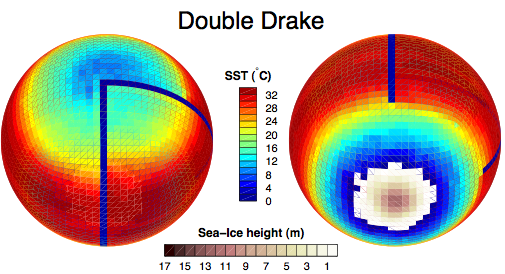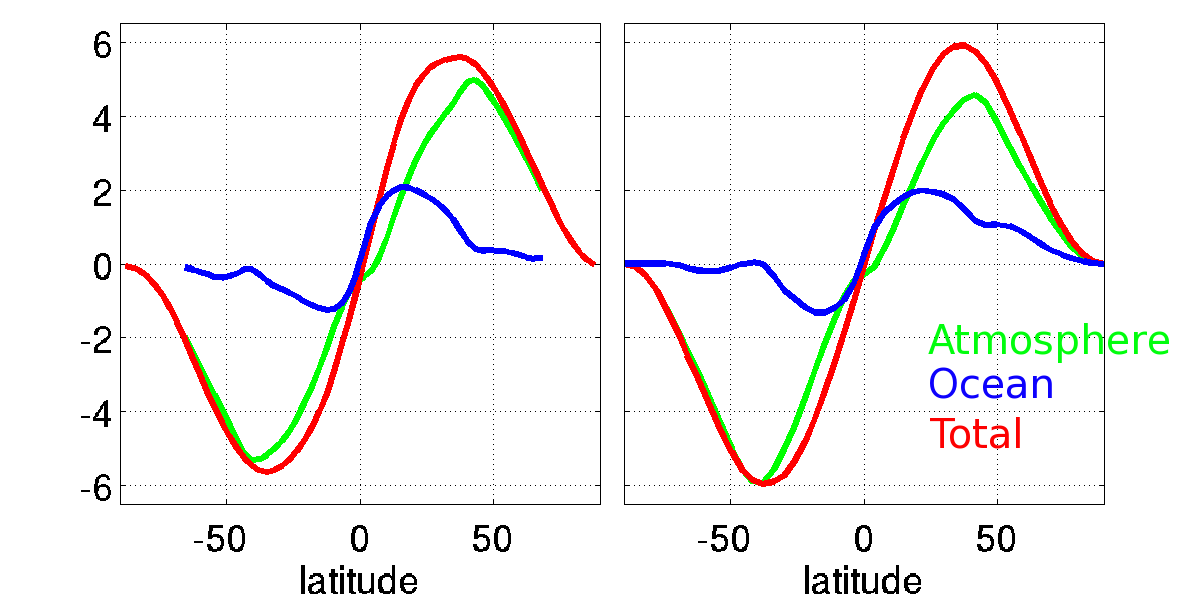Modelling Water Worlds
story by Helen HillUsing a coupled ocean-atmosphere version of the MITgcm to study an Earth-like planet which is entirely covered by ocean, David Ferreira and John Marshall, are exploring the elemental role of the ocean in climate. Geometrical constraints on ocean circulation due to the presence of land are represented by thin, single grid-point wide, slivers of land (as shown in fig 1.) , the modified aqua planet providing an elegant laboratory for investigating how geometry constrains oceanic circulation.

Figure 1. Sea-ice thickness from the Double Drake experiment. The northern pole is in view on the left, the southern pole on the right.
In the context of atmospheric modelling, aqua planets have been used extensively as a means of highlighting inter-model differences arising from different dynamical cores, different subgrid-scale parameterisations and the different methods whereby the two can be coupled. Here, modified aqua planets provide an elegant laboratory for investigating how geometry constrains oceanic circulation.
Figure 2 shows four of the configurations of the MITgcm coupled Ocean-Atmosphere-Sea-Ice Cubed-Sphere grid used in this work. Top left is a schematic of the pure aqua planet – a world free of bathymetry. Top right is ‘Ridge-World’: a planet with a single ocean basin prescribed by a pole-to-pole ridge extending from the bottom of the ocean to the sea surface. Bottom left is ‘Drake-World’: again with a single ridge extending latitudinally from the north but now ending at 35°S to admit circumpolar flow in the lower hemisphere. Bottom right is ‘Double-Drake-World’: now with twin ridges, 90° apart, creating a zonally asymmetic two basin system. In all cases the remaining domain has a flat bottom of depth 3000m. The Double Drake represents both zonal and interhemispheric asymmetries and captures essential aspects of the role of the ocean in climate.

Figure 3. Heat Transport Compared (left: observations, Trenberth and Carron, 2001, right: Double-Drake results).
Figure 3 illustrates how the distribution of continents impacts climate. Atmospheric (green), oceanic (blue) and total (red) heat transports diagnosed in ‘Double-Drake’ (to right) can be seen to closely mimic those observed in real world observations (to left).
Want to find out more? – contact David Ferreira
References:
Czaja, A. and J. C. Marshall, 2006: The partitioning of poleward heat transport between the atmosphere and ocean , J. Atm. Sciences, 63, 1498-1511. (PDF)
Enderton, D. and J. Marshall, 2008: Controls on the total dynamical heat transport of the atmosphere and oceans: to appear J. Atmos.Sci (PDF)
Ferreira, D., J. Marshall, and J.-M. Campin, 2009: Role of geometrical constraints on ocean circulation in setting the mean climate. Submitted to Journal of Climate (PDF)
Marshall, J., D. Ferreira, J-M Campin and D. Enderton, 2007: Mean climate and variability of the atmosphere and ocean on an aqua-planet: J. Atm. Science, DOI: 10.1175/2007 JAS2226.1 (PDF)


